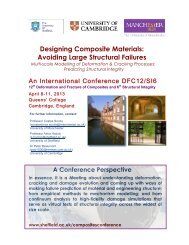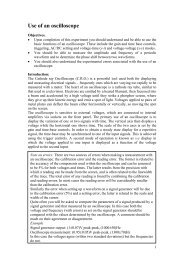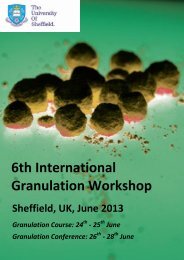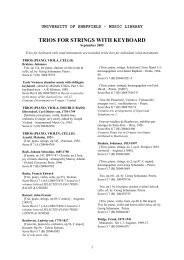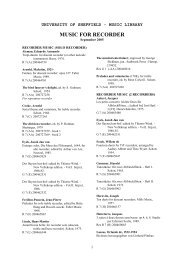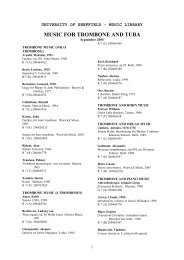The Eighteenth-Century Landscape Workshop - University of Sheffield
The Eighteenth-Century Landscape Workshop - University of Sheffield
The Eighteenth-Century Landscape Workshop - University of Sheffield
You also want an ePaper? Increase the reach of your titles
YUMPU automatically turns print PDFs into web optimized ePapers that Google loves.
<strong>The</strong> <strong>Eighteenth</strong>-<strong>Century</strong> <strong>Landscape</strong><br />
Friday 17 May 2013<br />
Floor 13, Arts Tower<br />
Cannon Hall, Barnsley Metropolitan Borough Council<br />
A workshop organized by the<br />
<strong>Eighteenth</strong> <strong>Century</strong> Study Group<br />
<strong>of</strong> the <strong>University</strong> <strong>of</strong> <strong>Sheffield</strong><br />
Karen Harvey and Jan Woudstra<br />
Contributers: Mark Bennett, Sally O’Halloran, Hae-Joon Jung, Nicola<br />
Walker, Jan Woudstra, Angela Wright<br />
ALL ARE WELCOME
<strong>The</strong> <strong>Eighteenth</strong>-<strong>Century</strong> <strong>Landscape</strong><br />
<strong>Workshop</strong><br />
Friday 17 May 2013<br />
Floor 13, Arts Tower, Western Bank<br />
PROGRAMME<br />
9.30 David McCallam ‘From Analogies to Patterns: Images in<br />
Geological Texts <strong>of</strong> the Mid-to-Late <strong>Eighteenth</strong> <strong>Century</strong>’<br />
10.15 COFFEE PROVIDED<br />
10.45 Mark Bennett, ‘“I see great capabilities about the venerable<br />
mansion!”: Locating the Gothic within <strong>Eighteenth</strong>-<strong>Century</strong><br />
<strong>Landscape</strong> Ideology’<br />
11.15 Hae-Joon Jung, ‘Experience and Commemoration in<br />
<strong>Landscape</strong> Arts in the Late Joseon Dynasty’<br />
11.45 Angela Wright, ‘Visiting the Swiss Alps, 1790-1820: the<br />
power and politics <strong>of</strong> landscape;<br />
12.30 LUNCH PROVIDED<br />
13.30 Nicola Walker, ‘<strong>The</strong> Park and Gardens <strong>of</strong> Cannon Hall’<br />
14.00 Jan Woudstra, ‘<strong>The</strong> influence <strong>of</strong> Robert Marnock on Bretton<br />
Hall, 1825-1834’<br />
14.30 Sally O’Halloran ‘<strong>The</strong> role <strong>of</strong> the gardeners at an English<br />
country estate- ‘<strong>The</strong> Garden Books at Arbury Hall, Nuneaton,<br />
Warwickshire from 1689 to 1703’<br />
15.00 Short contributions followed by discussion<br />
16.00 Finish<br />
2
<strong>The</strong> <strong>Eighteenth</strong>-<strong>Century</strong> <strong>Landscape</strong><br />
<strong>Workshop</strong><br />
Friday 17 May 2013<br />
ABSTRACTS<br />
‘From Analogies to Patterns: Images in Geological Texts <strong>of</strong> the Mid-to-Late<br />
<strong>Eighteenth</strong> <strong>Century</strong>’<br />
David McCallam<br />
<strong>The</strong> fieldwork <strong>of</strong> pioneering earth scientists, specifically those studying volcanic<br />
rock formations, effected an important shift in scientific visual culture in mid-tolate<br />
eighteenth-century Europe. Crudely put, this is a shift away from perceiving<br />
the works <strong>of</strong> nature in terms <strong>of</strong> rhetorical analogies towards conceptualizing<br />
nature on the basis <strong>of</strong> recurrent visual patterns. To make this point, this paper<br />
will consider three important volcanological texts <strong>of</strong> the second half <strong>of</strong> the<br />
eighteenth century, each illustrated with compelling images <strong>of</strong> regular and<br />
prismatic rock formations. <strong>The</strong>se texts are: Nicolas Desmarest’s geological<br />
contributions to the Encyclopédie <strong>of</strong> Diderot and d’Alembert; Thomas<br />
Pennant’s A Tour <strong>of</strong> Scotland, and Voyage to the Hebrides (1772); and Barthélemy<br />
Faujas de Saint-Fond’s Recherches sur les volcans éteints du Vivarais et du<br />
Velay (1778). First and foremost, in earth science terms, these works constitute a<br />
necessary step away from discursive attempts to comprehend the geophysics <strong>of</strong><br />
volcanism, largely via analogies, towards the visually dominant paradigm <strong>of</strong><br />
mineralogical maps (such as Guettard, Lavoisier and Monnet’s Atlas<br />
minéralogique <strong>of</strong> 1780) and geological charts (culminating famously in William<br />
Smith’s comprehensive A Delineation <strong>of</strong> the Strata <strong>of</strong> England and Wales with<br />
part <strong>of</strong> Scotland <strong>of</strong> 1815). Yet, this paper will contend, the pictorial stylizations <strong>of</strong><br />
these geological features also create unintentional but significant effects <strong>of</strong><br />
meaning. <strong>The</strong>y idealize the columns, caves and outcrops to the point <strong>of</strong> making<br />
them architectural, rather than natural. This in turn informs the language used in<br />
3
the texts and supports a growing tendency among mountain explorers in the late<br />
eighteenth century to import architectural terms to define and classify the rock<br />
formations they are examining. It points also to a more general ‘romanticization’<br />
<strong>of</strong> nature, so that naturally occurring geological features are described as ‘ruins’,<br />
with the implication that they once composed more perfect, divinely designed<br />
mountainscapes.<br />
“I see great capabilities about the venerable mansion!”: Locating the Gothic<br />
within <strong>Eighteenth</strong>-<strong>Century</strong> <strong>Landscape</strong> Ideology<br />
Mark Bennett<br />
Deriving from my PhD research on the relationship between Gothic and Travel<br />
Writing, this paper will explore the role competing theories <strong>of</strong> landscape and<br />
estate-management had in culturally locating the <strong>Eighteenth</strong> <strong>Century</strong> Gothic<br />
Imagination. It will identify the way in which an association between Gothic<br />
tyranny and supposedly despotic levelling practices is established in the work <strong>of</strong><br />
Picturesque theorists and sympathetic poets before being taken up by early<br />
Gothic novelists such as Charlotte Smith.<br />
Critics have identified the way Uvedale Price and Richard Knight’s theory <strong>of</strong><br />
Picturesque estate-management encodes a political challenge to Brownian<br />
landscaping. It sees levelling as a dangerously insensitive elision <strong>of</strong> the<br />
traditional relationship between landowner and tenants, whose presence is<br />
removed from the levelled view just as their claim to common land is removed<br />
by the enclosure that might fund it. <strong>The</strong>se economics further undermine the<br />
landowner’s responsibility for his tenants as, in Cowper’s words, “estates are<br />
landscapes, gazed upon a while, / <strong>The</strong>n advertised and auctioneered away.” In<br />
contrast, the Picturesque landowner evinces traditional paternalistic localism<br />
and encodes this in aesthetics that emphasise natural idiosyncrasies and the<br />
integration <strong>of</strong> tenant livelihoods. This benevolent authority is in sharp contrast<br />
to the Gothically inflected “tyrant hand” Goldsmith sees turning estates into<br />
“mouldering” ruins.<br />
4
Meanwhile, Picturesque travellers such as William Gilpin routinely describe both<br />
modern estates and “Gothic” ruins. <strong>The</strong> former must be differentiated from the<br />
latter so that the enlightened Picturesque gaze affirms the transience <strong>of</strong> the<br />
feudal past whilst praising the benevolence <strong>of</strong> the sensitive landowner.<br />
Smith’s first fiction embodies this model in the 1780s. Her villains’ Picturesque<br />
insensitivity enables her Gothic plots, whilst politically and aesthetically<br />
sensitive heroes eventually curtail them. In this way the Picturesque provides a<br />
way to recognise and safely incorporate the Gothic (for the time being) within an<br />
existing ideological vision <strong>of</strong> the <strong>Eighteenth</strong> <strong>Century</strong> landscape.<br />
Experience and Commemoration in <strong>Landscape</strong> Arts in the Late Joseon<br />
Dynasty<br />
Hae-Joon Jung (Department <strong>of</strong> <strong>Landscape</strong>)<br />
During the Joseon Dynasty (1392~1897) the popularity <strong>of</strong> Shan-sui (or<br />
landscape, 山 水 ) paintings and poems became the cultural prototype for the<br />
ideal place for the intellectuals, encouraging appreciation <strong>of</strong> landscapes and<br />
gardens. <strong>The</strong> late Joseon Dynasty (1700~1850) was a period in which Korea<br />
went through a cultural renaissance, promoted by enlightened Kings<br />
Yeongjo(1694~1776) and Jeongjo(1752~1800). <strong>The</strong> era <strong>of</strong> peace and prosperity<br />
changed the perspective <strong>of</strong> nature, from unconditionally following the<br />
philosophical principles to emphasizing direct experiences and chasing aesthetic<br />
values. This ideology was reflected in the fashionable activities among the<br />
intellectuals and aristocracy, for example, collecting and cultivating exotic plants,<br />
excursions to famous mountains, and building houses with gardens in scenic<br />
areas. <strong>The</strong>se cultural phenomena can be identified in literature and painting that<br />
depict the intellectuals’ enjoyment and their ideal landscape.<br />
In this period, the Jingyeong style <strong>of</strong> landscape painting (or real landscape<br />
painting, 眞 景 山 水 畵 ) was established with the paintings and calligraphic works<br />
<strong>of</strong> Palgyeong(or eight scenes, 八 景 ), which depicts the most beautiful or<br />
otherwise significant scenes <strong>of</strong> a certain area. Under the influence <strong>of</strong> Jingyeong<br />
5
landscape painting, Ahoi-do (or the painting <strong>of</strong> the elegant assembly, 雅 會 圖 ),<br />
that was a record painting depicting people enjoying a landscape garden, and<br />
Poongsu Myungdang-do genre (or the painting <strong>of</strong> the propitious site according to<br />
Feng-shui theory, 風 水 明 堂 圖 ), that reflected people’s wellbeing in harmony<br />
with nature, became pervasive. <strong>The</strong>se types <strong>of</strong> landscape arts could be broadly<br />
categorised into the ‘strolling( 遊 )’ shan-sui and ‘staying( 居 )’ shan-sui, which<br />
display experience and commemoration <strong>of</strong> outstanding landscapes on the way <strong>of</strong><br />
outdoor excursion and <strong>of</strong> places where the intellectuals stayed respectively.<br />
Later on, these even created a more distinct landscape culture, named Wayu<br />
culture (or imaginary stroll around nature at home, 臥 游 ) that represented<br />
ideology.<br />
This paper reveals how landscape arts in the late Joseon Dynasty reflected the<br />
landscape culture, and interacted with real scenes. For this purpose, a case study<br />
<strong>of</strong> Yun Seondo Garden, (Scenic Sites No. 34), which is referred to as a ‘propitious<br />
site type garden’ affected by Poongsu Myungdang painting, will be analysed and<br />
contextualized.<br />
Jeongwhang, Yianwhasuseoksiwhae-do (the painting <strong>of</strong> the poetry party<br />
celebrating 60 th birthday in a small cottage, 易 安 窩 壽 席 時 會 圖 ), 1789<br />
6
‘<strong>The</strong> influence <strong>of</strong> Robert Marnock on Bretton Hall, 1825-1834’<br />
Jan Woudstra (Department <strong>of</strong> <strong>Landscape</strong>)<br />
Despite being one <strong>of</strong> the most productive landscape gardeners <strong>of</strong> the nineteenth<br />
century little is known about Robert Marnock (1800-89). He first emerged as a<br />
fully-fledged practitioner when he won the design for, and subsequently became<br />
curator <strong>of</strong>, the <strong>Sheffield</strong> Botanic Garden in 1834. This paper investigates the<br />
period immediately before, which he spend at Bretton Hall, Yorkshire. Here<br />
under Diana Beaumont, its notorious owner, Marnock was able to broaden his<br />
perspective outside the kitchen garden, becoming head gardener in 1829, which<br />
position enabled him to acquire further skills. He brought these to practice for<br />
Beaumont’s son who inherited the estate after her death in 1831. Evidence<br />
emerges <strong>of</strong> Marnock's milieu, as well as his practical skills and demeanour, that<br />
enabled him to occupy key positions in nineteenth-century horticulture.<br />
<strong>The</strong> Park and Gardens <strong>of</strong> Cannon Hall<br />
Nicola Walker (Department <strong>of</strong> History)<br />
In 1760 John Spencer <strong>of</strong> Cannon Hall employed Richard Woods to redesign the<br />
park and gardens on his estate. John was keenly aware <strong>of</strong> recent improvements<br />
made by his contemporaries even before he inherited the family estate. His<br />
diaries reveal frequent visits to the estates <strong>of</strong> his peers and betters, whilst the<br />
rich descriptions reveal his impressions <strong>of</strong> what he saw, his taste for new design<br />
and a desire to emulate others in his social sphere. <strong>The</strong> ongoing project to<br />
reinterpret the park and gardens <strong>of</strong> Cannon Hall has utilised current<br />
historiographical debate on garden design alongside the rich archive <strong>of</strong> the<br />
Spencer-Stanhope family to reinvigorate the narrative <strong>of</strong> the landscape <strong>of</strong> this<br />
country house.<br />
7
It appears that Cannon Hall represents a typical example <strong>of</strong> garden design for the<br />
period, reflecting the taste and style <strong>of</strong> the county elite for the landscaped park<br />
and richly planted pleasure gardens. Through the use <strong>of</strong> original plans, lists <strong>of</strong><br />
trees and plants and diary extracts, I propose to give a brief tour <strong>of</strong> the landscape<br />
and reveal some <strong>of</strong> the contemporary significance <strong>of</strong> the space. Specific<br />
consideration will be given to the contemporary and historical importance <strong>of</strong> the<br />
grade II listed ha-ha, walled garden, pinery and the lakes, all <strong>of</strong> which were<br />
constructed as part <strong>of</strong> the program <strong>of</strong> redesign. Some <strong>of</strong> the 'hidden' histories <strong>of</strong><br />
the park will also be discussed including a rare original example <strong>of</strong> an eighteenth<br />
century icehouse. Discussion <strong>of</strong> the garden design will be positioned within<br />
current debate on formal garden design and their architects, but will also<br />
consider the heavy influence <strong>of</strong> the eighteenth century fascination with the<br />
unusual and exotic and the leisure pursuits <strong>of</strong> the county gentleman, all <strong>of</strong> which<br />
help to give meaning to a highly constructed yet incredibly personal landscape.<br />
<strong>The</strong> role <strong>of</strong> the gardeners at an English country estate- ‘<strong>The</strong> Garden Books at<br />
Arbury Hall, Nuneaton, Warwickshire from 1689 to 1703’<br />
Sally O’ Halloran (Department <strong>of</strong> <strong>Landscape</strong>)<br />
<strong>The</strong> pr<strong>of</strong>essionalization <strong>of</strong> gardeners and gardening in England from 1650 to 1730<br />
occurred in a period <strong>of</strong> significant horticultural progress, however this stage has<br />
been largely overlooked by the later development <strong>of</strong> the landscape garden. <strong>The</strong><br />
earlier period saw the intensification <strong>of</strong> the formal garden, which has <strong>of</strong>ten been<br />
attributed to designers and estate owners, with the input <strong>of</strong> gardeners themselves<br />
largely un-recognised. Three surviving ‘garden books’ written by the gardeners at<br />
Arbury Hall in Warwickshire allows us to recover a significant amount <strong>of</strong><br />
information about the day-to-day grounds management <strong>of</strong> an early modern English<br />
stately home. 1 <strong>The</strong>se manuscripts, which date from 1689 to 1703, <strong>of</strong>fer a first-hand<br />
account <strong>of</strong> the duties that were undertaken from ‘Munday to Saturday’ in the<br />
management <strong>of</strong> gardens and parks. In addition, they allow us to recover the lost role<br />
1 County Record Office, Warwickshire CR1841/58, '<strong>The</strong> Garden Book', August 1689-November 1692.<br />
CR1841/28 ‘January 1699/1700 to July 1701’ and CR 1841/27 ‘August 1701 to March 1703’.<br />
All following CR references are from the County Record Office in Warwick.<br />
8
<strong>of</strong> the early modern gardener. Generally assumed to have been involved solely in<br />
the maintenance <strong>of</strong> gardens, these manuscripts demonstrate without doubt that the<br />
gardeners were largely responsible for the ongoing management <strong>of</strong> the gardens at<br />
Arbury. 2 <strong>The</strong>y are a typical example <strong>of</strong> the many pr<strong>of</strong>essional gardeners who were<br />
‘in service’ but whose role was never highlighted and has remained invisible to date.<br />
ORIGINAL CALL FOR PAPERS FOR THE WORKSHOP<br />
2016 will be the Tricentenary Year <strong>of</strong> the Birth <strong>of</strong> Capability Brown, England's<br />
most famous landscape gardener. During that year there will be much focus on<br />
the eighteenth-century landscape garden. We propose to explore what<br />
researchers at the <strong>University</strong> <strong>of</strong> <strong>Sheffield</strong> might contribute to this discussion <strong>of</strong><br />
landscape gardens and landscape more broadly, and particularly from a more<br />
multidisciplinary perspective. In the first <strong>of</strong> what we hope will be a series <strong>of</strong><br />
events, this <strong>Workshop</strong> will scope the research undertaken at the <strong>University</strong> that<br />
might be considered to have general relevance to landscape, or provide it with a<br />
broader context. For the purposes <strong>of</strong> the day we are considering the wider<br />
eighteenth century, from 1650-1830. We invite contributions from academics<br />
and research students from any department.<br />
2 None <strong>of</strong> the gardeners that were employed at Arbury from 1689 until 1703 are recorded in Ray<br />
Desmond’s Dictionary <strong>of</strong> British and Irish Botanists and Horticulturalists: Including Plant Collectors,<br />
Flower Painters and Garden Designers, (London: Taylor & Francis and <strong>The</strong> Natural History Museum,<br />
1994).<br />
9



